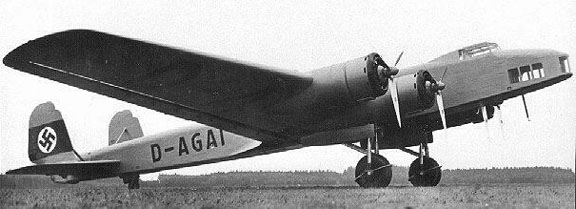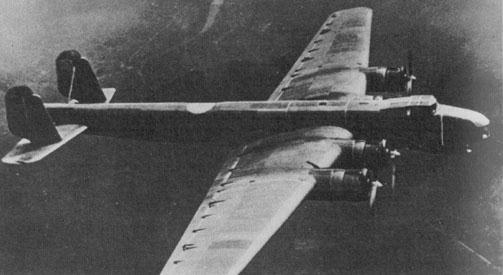
|
Type: Strategic Bomber Origin: Dornier-Werke GmbH Models: V1 and V2 Production: Two prototypes First Flight: October 28, 1936 Powerplant: Do 19V-1: Model: Bramo (Siemens) 323H-2 Fafnir Type: 9-cylinder radial Number: 4 Horsepower: 715 hp Do 19V-2: Model: BMW 132F Radial Number: 4 Horsepower: 810 hp Dimensions: Wing span: 35m (114 ft. 9.75 in.) Wing Surface Area: 162.00m² (1,743.81 Sq. Ft.) Length: 25.4m (83 ft. 5.74 in.) Height: 5.77m (18 ft. 11.5 in.) Weights: Empty: 11,865kg (26,158 lbs.) Loaded: 18,500kg (40,785 lbs.) |
Performance: Maximum Speed (at Sea Level): 196 mph (315 kph) Cruising Speed: 155 mph (250 kph) Range: 1600km (994 miles) Initial Climb: N/A Endurance: N/A Service Ceiling: 18,370 ft. (5600 km) Armament: (Stats For V 2) One 7.92mm MG 15 Machine Gun in nose One 7.92mm MG 15 Machine Gun in tail One 20mm Cannon mounted in two-man dorsal turret One 20mm Cannon mounted in two-man ventral turret Payload: Sixteen 100kg (220lb) bombs |
Along with the Junkers Ju 89, the Do 19 was developed as part of the "Ural Bomber" program championed by Gen. Walther Wever who forsaw the need for long range strategic bombing capability. When Gen. Wever was killed in April of 1936, the goal of a strategic bombing capability died with him. On April 29, 1937, the Ural-Bomber bomber program was cancelled by Kesselring in spite of protests. Kesselring felt the production and development resources would be better used to develop and build tactical bombers such as the Do 17 and He 111. This philosophy would later haunt and severely handicap the Luftwaffes ability to strike at Russia's production capabilities.



Gunston, Bill & Wood, Tony - Hitler's Luftwaffe
Donald, David - The Complete Encyclopedia Of World Aircraft, 1997, Brown Packaging Books Ltd., London
LUFTWAFFE RESOURCE CENTER > BOMBERS > PREVIOUS PAGE
